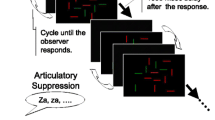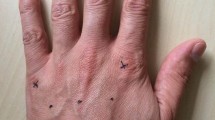Abstract
The localisation of tactile stimuli requires the integration of visual and somatosensory inputs within an internal representation of the body surface and is prone to consistent bias. Joints may play a role in segmenting such internal body representations, and may therefore influence tactile localisation biases, although the nature of this influence remains unclear. Here, we investigate the relationship between conceptual knowledge of joint locations and tactile localisation biases on the hand. In one task, participants localised tactile stimuli applied to the dorsum of their hand. A distal localisation bias was observed in all participants, consistent with previous results. We also manipulated the availability of visual information during this task, to determine whether the absence of this information could account for the distal bias observed here and by Mancini et al. (Neuropsychologia 49:1194–1201, 2011). The observed distal bias increased in magnitude when visual information was restricted, without a corresponding decrease in precision. In a separate task, the same participants indicated, from memory, knuckle locations on a silhouette image of their hand. Analogous distal biases were also seen in the knuckle localisation task. The accuracy of conceptual joint knowledge was not correlated with tactile localisation bias magnitude, although a similarity in observed bias direction suggests that both tasks may rely on a common, higher-order body representation. These results also suggest that distortions of conceptual body representation may be more common in healthy individuals than previously thought.




Similar content being viewed by others
References
Alloway KD, Rosenthal P, Burton H (1989) Quantitative measurements of receptive field changes during antagonism of GABAergic transmission in primary somatosensory cortex of cats. Exp Brain Res 78:514–532
Azañón E, Longo MR, Soto-Faraco S, Haggard P (2010) The posterior parietal cortex remaps touch into external space. Curr Biol 20:1304–1309
Batschelet E (1981) Circular statistics in biology. Academic Press, New York
Berens P (2009) CircStat: a MATLAB toolbox for circular statistics. J Stat Softw 31:1–21
Bookstein FL (1991) Morphometric tools for landmark data. Cambridge University Press, Cambridge
Boring EG (1942) Sensation and perception in the history of experimental psychology. Appleton-Century, New York
Brooks VB, Rudomin P, Slayman CL (1961) Peripheral receptive fields of neurons in the cat’s cerebral cortex. J Neurophysiol 24:302–325
Buxbaum LJ, Coslett HB (2001) Specialized structural descriptions for human body parts: evidence from autotopagnosia. Cogn Neuropsychol 18:289–306
Cash TF, Deagle EA III (1997) The nature and extent of body-image disturbances in anorexia nervosa and bulimia nervosa: a meta-analysis. Int J Eat Disord 22:107–125
Cholewiak RW, Collins AA (2003) Vibrotactile localization on the arm: effects of place, space and age. Percept Psychophys 65:1058–1077
Cholewiak RW, Brill JC, Schwab A (2004) Vibrotactile localization on the abdomen: effects of place and space. Percept Psychophys 66:970–987
Cody FW, Garside RA, Lloyd D, Poliakoff E (2008) Tactile spatial acuity varies with site and axis in the human upper limb. Neurosci Lett 433:103–108
Critchley M (1953) The parietal lobes. Edward Arnold & Co, London
Culver CM (1970) Errors in tactile localization. Am J Psychol 83:420–427
de Vignemont F, Majid M, Jola C, Haggard P (2009) Segmenting the body into parts: evidence from biases in tactile perception. Q J Exp Psychol 62:500–512
Fuentes CT, Longo MR, Haggard P (2013) Body image distortions in healthy adults. Acta Psychol 144:344–351
Harrar V, Harris LR (2009) Eye position affects the perceived location of touch. Exp Brain Res 198:403–410
Harrar V, Pritchett LM, Harris LR (2013) Segmented space: measuring tactile localisation in body coordinates. Multisens Res 26:3–18
Harris JA, Thein T, Clifford CW (2004) Dissociating detection from localization of tactile stimuli. J Neurosci 24:3683–3693
Kemmerer D, Tranel D (2008) Searching for the elusive neural substrates of body part terms: a neuropsychological study. Cogn Neuropsychol 25:601–629
Kennett S, Taylor-Clark M, Haggard P (2001) Noninformative vision improves the spatial resolution of touch in humans. Curr Biol 11:1188–1191
Knight FLC, Longo MR, Bremner AJ (2014) Categorical perception of tactile distance. Cognition 131:254–262
Longo MR, Haggard P (2010) An implicit body representation underlying human position sense. Proc Natl Acad Sci USA 107:11727–11732
Longo MR, Haggard P (2012) A 2.5-D representation of the human hand. J Exp Psychol Hum Percept Perform 38:9–13
Mancini F, Longo MR, Iannetti GD, Haggard P (2011) A supramodal representation of the body surface. Neuropsychologia 49:1194–1201
Moore CE, Schady W (1995) Cutaneous localisation of laser induced pain in humans. Neurosci Lett 193:208–210
Pritchett LM, Harris LR (2011) Perceived touch location is coded using a gaze signal. Exp Brain Res 213:229–234
Pritchett LM, Carnevale MJ, Harris LR (2012) Reference frames for coding touch location depend on the task. Exp Brain Res 222:437–445
Sirigu A, Grafman J, Bressler K, Sunderland T (1991) Multiple representations contribute to body knowledge processing. Brain 114:629–642
Steenbergen P, Buitenweg JR, Trojan J, Klaassen B, Veltink PH (2012) Subject-level differences in reported locations of cutaneous tactile and nociceptive stimuli. Front Hum Neurosci 6:325
Trojan J, Kleinböhl D, Stolle AM, Andersen OK, Hölzl R, Arendt-Nielsen L (2006) Psychophysical ‘perceptual maps’ of heat and pain sensations by direct localization of CO2 laser stimuli on the skin. Brain Res 1120:106–113
Weber EH (1834/1996) De subtilitate tactus (H. E. Ross, Trans.). In: Ross HE, Murray DJ (eds) E. H. Weber on the tactile senses, 2nd edn (pp 21–128). Academic Press, London, pp 21–128
Acknowledgments
This research was supported by a Grant from the European Research Council (ERC-2013-StG-336050) to MRL.
Author information
Authors and Affiliations
Corresponding author
Rights and permissions
About this article
Cite this article
Margolis, A.N., Longo, M.R. Visual detail about the body modulates tactile localisation biases. Exp Brain Res 233, 351–358 (2015). https://doi.org/10.1007/s00221-014-4118-3
Received:
Accepted:
Published:
Issue Date:
DOI: https://doi.org/10.1007/s00221-014-4118-3




